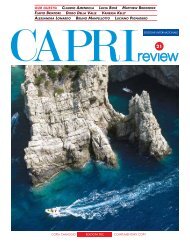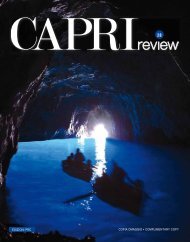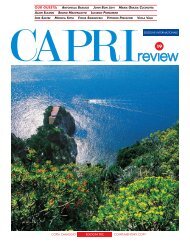You also want an ePaper? Increase the reach of your titles
YUMPU automatically turns print PDFs into web optimized ePapers that Google loves.
THE SEA IN PAINTING<br />
by Ludovico Pratesi<br />
Coastlines, beaches, waves,<br />
rocks. Seascapes have always<br />
been a source of inspiration for<br />
the great artists<br />
In a country like Italy, a peninsula<br />
surrounded by water, it is not surprising<br />
that many artists have celebrated the<br />
sea as a principal feature of the landscape.<br />
Ever since the Renaissance, seascapes<br />
have featured in paintings from as early<br />
as the first view of the city of Naples in the<br />
mysterious Tavola Strozzi, a brush painting<br />
by a Neapolitan artist around the middle<br />
of the fifteenth century, depicting Naples<br />
overlooking the bay. And it is not by chance<br />
that the luminous landscapes painted in the<br />
century of the Grand Tour, by artists such as<br />
Gaspar Van Wittel, Salvator Rosa, Antonio<br />
Joli and Jakob Philipp Hackert, interpreted so<br />
intensely and strikingly the luminosity of the<br />
waters of the Gulf with the islands of Ischia,<br />
Procida and <strong>Capri</strong> rising from the water. The<br />
rocks, coastlines, beaches and cliffs all stand<br />
out as extraordinary sources of inspiration for<br />
painters of the nineteenth century who sought<br />
to interpret the beauty of the Neapolitan<br />
landscape. So while the masters of the<br />
Posillipo School, such as Filippo Palizzi<br />
and Giacinto Gigante, carried out their work<br />
between the Chiaia coast and San Martino,<br />
some of their colleagues devoted themselves<br />
specifically to the magic of <strong>Capri</strong>, such as<br />
the Sicilian painter Antonino Leto (1844-<br />
1913) who settled permanently on <strong>Capri</strong> in<br />
1882, in order to paint the most beautiful<br />
corners of the island. Another great fan of the<br />
Faraglioni is Giuseppe Garelli (1858-1921),<br />
who was mainly interested in the quality of<br />
the Mediterranean light which he transferred<br />
onto the canvas with a frayed, mellow painting<br />
style similar to that of his Neapolitan colleague<br />
Carmine Giardiello (1871-1916), who was<br />
fascinated by the daily life of the fishermen,<br />
which he depicted with a vibrant and vigorous,<br />
almost impressionist, style. He had this<br />
technique in common with Fausto Pratella<br />
(1888-1964), who painted a charming view of<br />
the <strong>Capri</strong> harbour, livened by the waves on a<br />
slightly choppy sea. Karl Wilhelm Diefenbach<br />
(1851-1913), who lived like a hermit in a cave<br />
among the rocks on <strong>Capri</strong> for thirteen years,<br />
saw the island in a wilder, more romantic<br />
light. “<strong>Capri</strong> would suffice me all my life, with<br />
these rough crags that I love, and the terrible,<br />
beautiful sea,” wrote this artist, who loved the<br />
island and the bright blue glinting sea more<br />
than any other artist.<br />
<br />
71







